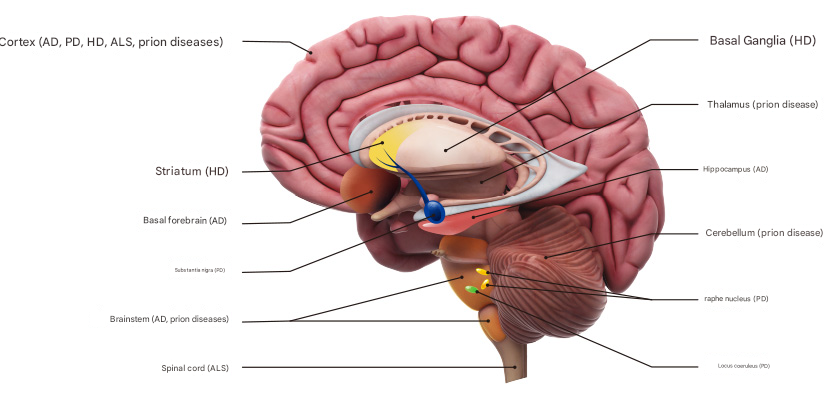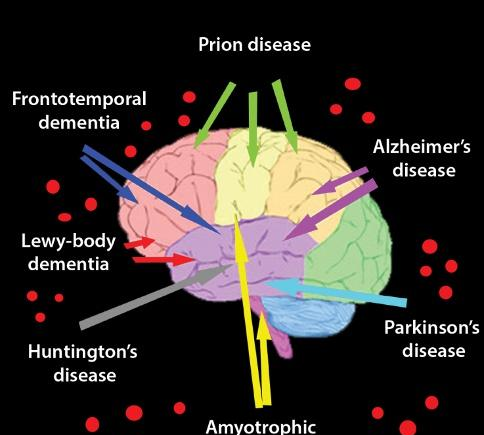- Cart 0
- English
Neurodegenerative disease profile
What are neurodegenerative diseases?
Neurodegenerative diseases (NDs) are neuronal dysfunction caused by the loss of neurons and their myelin sheaths, which manifest with clinical symptoms such as motor dysfunction, cognitive decline, and dementia depending on the affected brain region.

Fig.1 Brain regions associated with various neurodegenerative diseases
What are the common neurodegenerative diseases? What are the typical indicators?
Alzheimer's Disease: The most common type of dementia that affects memory, thinking and behaviour. Classic indicators include:
Amyloid-beta (Aβ): Aβ plaque is one of the pathological features of AD, and Aβ42 is a subtype specifically associated with Aβ plaque formation. The decrease in Aβ42 levels in cerebrospinal fluid (CSF) is associated with the deposition of Aβ plaques in the brain;
Tau:Neurofibrillary tangles formed after abnormal phosphorylation of Tau protein are another key pathological hallmark of AD. The Thr181 locus (pTau181) and Thr217 locus (pTau217) of phosphoTau (pTau) are commonly used markers in research. pTau181 is a well-established marker in CSF for the diagnosis of AD, while pTau217 has shown better diagnostic performance as a new marker.
Parkinson's disease: characterised by movement disorders such as tremors, muscle stiffness, and bradykinesia;
α-Synuclein (α-Synuclein, α-Syn): α-synuclein is one of the main pathological markers of Parkinson's disease, mainly accumulating in Lewy bodies and Lewy protrusions.
Tau:The neurofibrillary tangles formed by the abnormal accumulation of tau protein are associated with the pathological process of Parkinson's disease, especially in progressive ascending nuclear palsy (PSP) and corticobasal degeneration (CBD).
Huntington's disease: a genetic disorder that causes loss of motor control and cognitive decline;
Huntingtin (HTT) and its mutant form (mHTT): Huntingtin is detectable in cerebrospinal fluid (CSF) under both normal and pathological conditions. Under pathological conditions, mHTT can be quantitatively detected in CSF due to the functioning of the cerebrospinal fluid clearance system. The concentration of mHTT in symptomatic individuals was higher than in presymptomatic individuals, and was positively correlated with disease stage, motor score (e.g., Unified Huntington's Disease Rating Scale (UHDRS), and cognitive performance;
Amyotrophic lateral sclerosis (ALS): affects the nerve cells that control muscle movement, resulting in gradual muscle weakness and atrophy;
Neurofilament light chain (NFL or NEFL): The study found that the concentration of NF-L in the cerebrospinal fluid of ALS patients was 10 times higher than that in the healthy group, and the NF-L concentration was significantly increased in cerebrospinal fluid, serum, and plasma. In addition, higher NF-L levels in ALS patients were associated with a faster rate of disease progression, suggesting that NF-L could be used as a biomarker to predict ALS survival;

Fig.2 Immunohistochemical analysis of NEFL staining of formalin-fixed, paraffin-embedded tissue sections of abs149865 human brain
Multiple sclerosis (MS): the immune system attacks the protective layer of nerve fibers, resulting in blockage of nerve signaling;
Neurofilament light chain (NFL or NEFL): NfL is the main structural protein located on neurons, and its levels increase when the axis breaks bad. Elevated NfL levels in patients with all stages of MS are associated with clinical manifestations and MRI findings, and are considered a valid MS biomarker.
Table 1 Common neurodegenerative diseases and their main features
|
disease |
Key features: |
|
Alzheimer's disease |
Memory loss, cognitive decline, amyloid plaques, tau tangles |
|
Parkinson's disease |
tremor, stiffness, bradykinesia, postural instability, loss of dopamine-producing neurons |
|
Amyotrophic lateral sclerosis (ALS) |
Muscle weakness, paralysis, respiratory failure, motor neuron degeneration |
|
Huntington's disease |
Loss of motor control, cognitive decline, psychiatric symptoms, HTT gene mutations |
Key features of neurodegenerative diseases
● Protein misfolding and pathological aggregation
Protein misfolding refers to the abnormal three-dimensional structure of a protein due to various reasons (such as mutations, environmental factors, etc.) during the synthesis process, thus losing its normal biological function. These misfolded proteins may clump together to form larger structures such as amyloid fibrils, and this aggregation process may lead to cell dysfunction and even cell death, which is closely related to the occurrence and development of a variety of neurodegenerative diseases, in Alzheimer's disease, the misfolding and aggregation of β-amyloid forms amyloid plaques, and in Parkinson's disease, the aggregation of α-synuclein forms Lewy bodies.

Fig.3 Deposition of denatured proteins in different brain regions of neurodegenerative diseases
● Dysfunction of synaptic and neuronal networks
In addition to being regulated by neurotransmitter and calcium changes, cytoskeletal adaptation, presynaptic vesicle dynamics, and postsynaptic signaling, astrocytes and microglia play an important role in energy and neurotransmitter homeostasis, synaptic elimination, and stabilization, which means that any factor affecting synaptic and neuronal network function may lead to neuronal network dysfunction, which in turn affects the course of neurodegenerative diseases. For example, synaptic failure and toxicity are early events of neuronal injury in many NDDs, and neuro-overexcitability and glutamate-mediated excitotoxicity are thought to be important etiological mechanisms of ALS.
● Neuroinflammation
Astrocytes and microglia play a central role in the innate immune response of the central nervous system, and neuroinflammation plays a key role in the development of neurodegenerative diseases such as Alzheimer's disease and Parkinson's disease by activating microglia and astrocytes, releasing pro-inflammatory cytokines and neurotoxic mediators, and exacerbating neuronal damage and degeneration.
● Changes in energy homeostasis
Neurons are extremely energy-demanding cells in the human body that rely on mitochondria to produce ATP through oxidative phosphorylation processes to maintain their energy-demanding functions, such as synaptic activity and dynamic changes in the cytoskeleton. Defects in energy metabolism are involved in the pathological processes of many NDDs, for example, mitochondrial dysfunction may lead to low ATP utilization, affecting the function of high energy demand processes within neurons, such as ion homeostasis, calcium homeostasis, cytoskeletal dynamics, and protease homeostasis. In addition, mitochondrial dysfunction may also lead to increased oxidative stress, which attacks proteins, lipids, and nucleic acids through reactive oxygen species (ROS), causing macromolecular damage, stimulating neuronal dysfunction, and ultimately leading to cell death.
● Neuronal cell death
Some intrinsic properties of neurons make them particularly susceptible to cell death in NDDs. These properties include: accumulation of age-related damage due to post-mitotic nature and inability to replicate replacement, high energy requirements, long-distance transport and structural organization requirements due to elongated axons and dendrites, dependence on glial cell maintenance, energy, and defense. Neuronal cell death may be caused by a variety of factors, including pathological protein aggregation, neuroinflammation, oxidative stress, etc. These factors, individually or together, can ultimately overwhelm the intrinsic resilience of neurons to internal and external damage, leading to neuronal loss and decreased function.
In addition to the above events, NDD features include DNA and RNA damage, cytoskeletal abnormalities, DNA methylation, and histone modifications, which are interrelated and complex, and also suggest the need for multi-targeted therapies, and a single NDD marker may not be sufficient to stop neurodegenerative processes.
Research ideas for neurodegenerative diseases
The research ideas of neurological diseases can be roughly divided into several aspects, such as target confirmation, model construction, model processing, and behavioral/phenotypic analysis.
● Target confirmation
A common method is to analyze the differences between normal and disease samples through GWAS, transcriptome, proteome, or metabolome to identify the key molecules associated with disease.
● Model building
Including cell models and animal models, animal models include gene-edited animals, germ-free mice, etc., cell models include primary cells, stem cell induced differentiation and cell lines (SH-5YSY, PC12, N2A, etc.), in neurodegenerative diseases, rat and mouse models account for a relatively high proportion, for example, in the study of Alzheimer's disease, through different mutations in APP, PS1, MAPT genes, a variety of different disease models have been produced. Phenotypes such as tau tangles and neuronal death appear at different times. In addition to these recognized animal models, they can also be constructed by natural senescence or by chemical induction such as Aβ injection into the hippocampus or ventricles, intraperitoneal injection of scopolamine, and ventricular injection of streptourea.
● Model processing
One of the more common treatments in neurodegenerative diseases is brain stereotactic injection, which can inject drugs or carrier viruses, in addition, according to the characteristics of the drug, it can also awaken the tail vein injection and other operations.

Fig.4 Schematic diagram of brain stereotaxic injection of virus in rats
● Behavioral experiments
This is a special point of neurological diseases, including learning, memory, movement, socialization, etc., in Alzheimer's disease, the more common are water maze, fear memory box, new object recognition, T/Y maze, etc., Parkinson's model behavioral test is more biased towards movement.
● Pathological detection
The most common pathological detection method for neurodegenerative diseases is tissue section staining, which can detect related pathological markers, such as age spots, etc., by histochemical means, and can also be detected by molecular, imaging, electrophysiology and other technologies.
● Mechanism exploration
Mechanistic research into degenerative diseases often takes up a lot of energy and space, and mechanistic exploration helps us understand the complexity of neurodegenerative diseases and provides targets for the development of therapeutic strategies.
Note: The pictures in the article are from the Internet and are for reference only
|
Catalog number |
Product name |
specification |
|
Mouse anti-Phospho-Tau(T181) Monoclonal Antibody(200-5) |
0.5mg |
|
|
Rabbit anti-Tau Recombinant Monoclonal Antibody(171-45) |
0.5mg |
|
|
Mouse anti-Phospho-Tau(T231) Monoclonal Antibody(202-2) |
0.5mg |
|
|
Mouse anti-Tau Recombinant Monoclonal Antibody(R145) |
100uL |
|
|
Rabbit anti-α-Synuclein Recombinant Monoclonal Antibody(S-441-86) |
100uL |
|
|
Mouse anti-Huntingtin Monoclonal Antibody(11557) |
100uL |
|
|
LC3-mHTT-IN-AN1 |
5mg |
|
|
Mouse anti-NEFL Monoclonal Antibody |
50uL |
Absin provides antibodies, proteins, ELISA kits, cell culture, detection kits, and other research reagents. If you have any product needs, please contact us.
|
Absin Bioscience Inc. Email: worldwide@absin.net |
 Follow us on Facebook: Absin Bio Follow us on Facebook: Absin Bio |
July 09, 2025
Clicks:104
